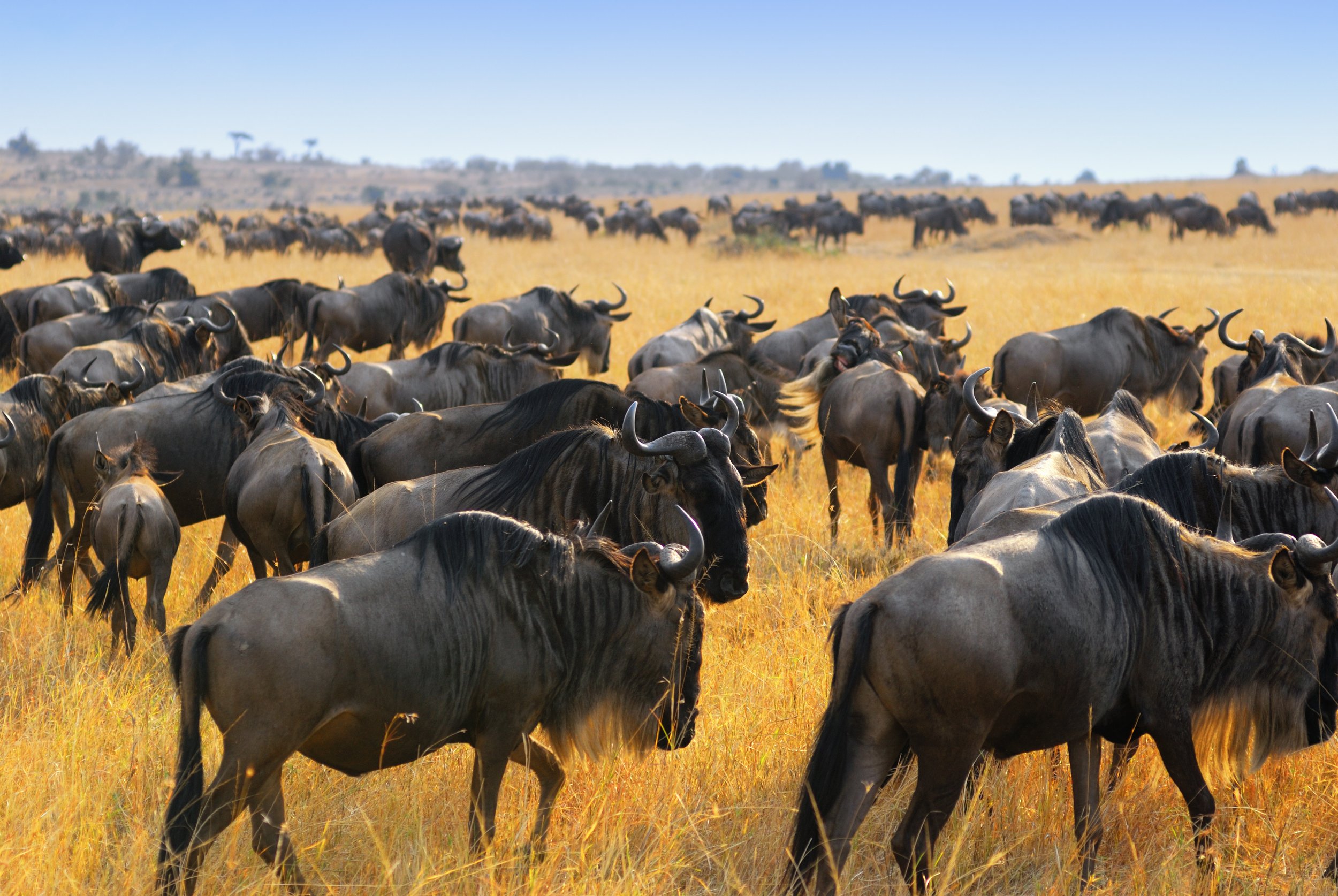
Witness the wildebeest migration in November
Liuwa Plains
Liuwa Plains is mesmerizingly beautiful, a landscape of expansive golden plains dotted with vivid blue pools, colourful carpets of flowers and an occasional palm tree piercing the horizon. By night, stars almost vie for space in inky skies, and flashes of lightening in distant storms dance across the heavens. Remote and raw, covering 3660 sq km, Liuwa is home to Africa’s second largest (yet little-known) wildebeest migration.
From December to April the wet season transforms the southern plains, with extensive floods attracting some 35,000 wildebeest to the fertile grasslands. As the floods recede from June, the braying herds follow the water north until they start their return journey south in September – it's a never-ending cyclical search for sustenance. The wildebeest provide ample fodder for Liuwa’s 500 or so hyena. These oft-maligned and misunderstood mavericks are fascinating to watch in their family groups, socialising, playing and preening together. With few lions around, hyena rule the roost here, hunting in clans of up to 50. Cheetahs also stalk the plains, and antelopes – from giant eland to tiny oribi – are easily seen on wildlife safari drives, as are herds of zebra, red lechwe and buffalo. The park is home to some 330 bird species, including hundreds of elegant crowned cranes, huge flocks of pelicans and endangered wattled cranes.
The legend of a celebrity lioness. Lady Liuwa was an icon, and a symbol of survival and resilience. Due to years of poaching and illegal trophy hunting, lions were completely eradicated from Liuwa Plain in the 1990’s, except for one lioness – Lady Liuwa. Her presence was first confirmed in 2002 and since then she roamed the plains for years as the sole survivor in the park. With no lions to be found, she looked to humans for companionship. Her extraordinary story of survival, as well as how African Parks helped give her a pride of her own, became one of the most moving wildlife films ever produced.
“Lady Liuwa was a truly exceptional lioness, so much so that it is impossible to do justice to her in words” said Peter Fearnhead, CEO of African Parks. “Oftentimes she would lie just five meters away from our camp-fire in the middle of the park. When it came time to go to bed, she would follow, walking parallel to the path and then fall asleep in front of one of our tents. In the mornings, we would find her in a tree, just watching but never threatening us. After years of being solitary, and after several reintroductions and careful management, we were finally able to unite her with her own kind. While her passing saddens us all, she leaves behind a legacy of survival in the small but growing pride in Liuwa Plain”.
The efforts to find Lady Liuwa her own family were not without setbacks. After five years of waiting for lions to return to Liuwa from the larger landscape, and after securing the park through improved law enforcement and working with local communities, African Parks reintroduced a male lion in 2008 to join Lady. Sadly, he died during the translocation process. A year later, two more males were reintroduced, both of whom mated with Lady Liuwa but she never produced any cubs, almost certainly because of her infertility. Two young lionesses were then reintroduced in 2011. However, in 2012 one of the females was killed by a poacher’s snare and the other, Sepo, fled towards the Angolan boundary. In a dramatic rescue mission, Sepo was darted, flown back to the park by helicopter and placed in a boma for safety along with Lady Liuwa to encourage Sepo to bond with Lady, critical for the young lioness' survival. And this time it worked. After two months, they were released back into the park, and were inseparable from that point forward. Sepo produced her first litter of cubs shortly thereafter. The growing pride suffered another setback when the two males left the park and entered Angola. One was shot and killed by villagers, but the other made it safely back to Liuwa on his own, where he became the resident male.
African Parks in collaboration with the Zambia Carnivore Programme (ZCP), DNPW and Mushingashi Conservancy reintroduced another male lion in September 2016 to help grow the pride and increase genetic integrity. The newly translocated male and the resident male were placed in a boma for two months to undergo the bonding process and then were successfully released into the park to join with the females. While the males were in the enclosure, Lady Liuwa and Sepo would visit them, sleeping just outside of it at night, and staying just a short distance from it during the day. On November 15th 2016 it was confirmed that Sepo had produced another two new cubs, sired by the resident male. While Lady Liuwa could not have cubs of her own, she was seen helping to raise Sepo’s numerous litters over the years, and it was clear that finally Lady Liuwa had a pride of her own.
Lady Liuwa’s exact age is unknown, but it is believed she was 17 years old, an extraordinary feat for a wild lion hunting and surviving on her own, and is a testament to the collaborative protection she was afforded by African Parks, the DNPW, ZCP and the BRE.
Where to Stay
Liuwa Plains offers one gorgeous lodge which sits higher up on the landscape, hosting endless panoramic views and an abundance of wildlife. There is also a campsite for those on a self-drive adventure.
Chat to Sarah about what would be best suited for you!
-
Time + Tide King Lewanika
-
National Parks Campsite


